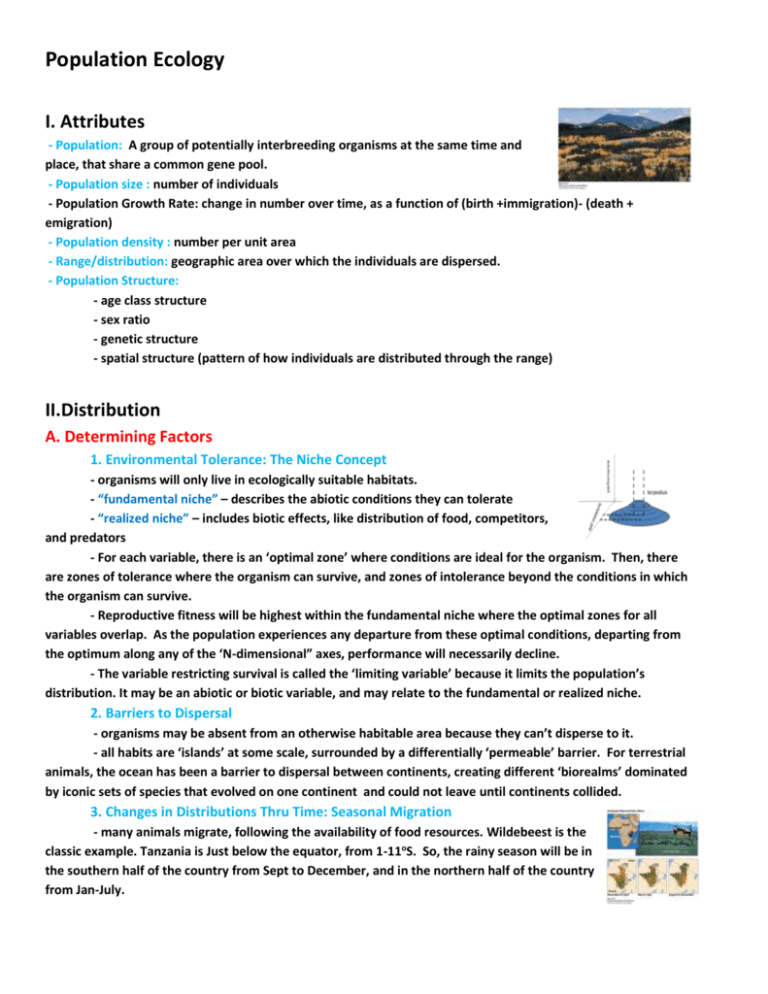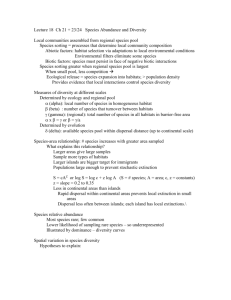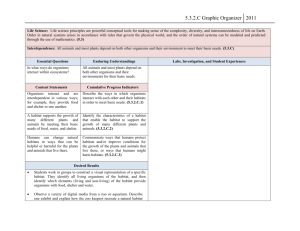Population Distributions
advertisement

Population Ecology I. Attributes - Population: A group of potentially interbreeding organisms at the same time and place, that share a common gene pool. - Population size : number of individuals - Population Growth Rate: change in number over time, as a function of (birth +immigration)- (death + emigration) - Population density : number per unit area - Range/distribution: geographic area over which the individuals are dispersed. - Population Structure: - age class structure - sex ratio - genetic structure - spatial structure (pattern of how individuals are distributed through the range) II.Distribution A. Determining Factors 1. Environmental Tolerance: The Niche Concept - organisms will only live in ecologically suitable habitats. - “fundamental niche” – describes the abiotic conditions they can tolerate - “realized niche” – includes biotic effects, like distribution of food, competitors, and predators - For each variable, there is an ‘optimal zone’ where conditions are ideal for the organism. Then, there are zones of tolerance where the organism can survive, and zones of intolerance beyond the conditions in which the organism can survive. - Reproductive fitness will be highest within the fundamental niche where the optimal zones for all variables overlap. As the population experiences any departure from these optimal conditions, departing from the optimum along any of the ‘N-dimensional” axes, performance will necessarily decline. - The variable restricting survival is called the ‘limiting variable’ because it limits the population’s distribution. It may be an abiotic or biotic variable, and may relate to the fundamental or realized niche. 2. Barriers to Dispersal - organisms may be absent from an otherwise habitable area because they can’t disperse to it. - all habits are ‘islands’ at some scale, surrounded by a differentially ‘permeable’ barrier. For terrestrial animals, the ocean has been a barrier to dispersal between continents, creating different ‘biorealms’ dominated by iconic sets of species that evolved on one continent and could not leave until continents collided. 3. Changes in Distributions Thru Time: Seasonal Migration - many animals migrate, following the availability of food resources. Wildebeest is the classic example. Tanzania is Just below the equator, from 1-11oS. So, the rainy season will be in the southern half of the country from Sept to December, and in the northern half of the country from Jan-July. 4. Changes in Distributions Thru Time: Climate Change - As environments change, the geographical area that contains the fundamental niche requirements may move, expand, or contract… necessitating a behavioral (migratory) or evolutionary (adapting to new local environment) response. - Marine fishes are moving north into the north Sea as water temps increase. - Alpine mammals, birds, and plants are increasing their elevation (and decreasing the size of their habitat and population). - Some scientists estimate that 35% of species may go extinct in the next 50 years because of climate change and these types of range shifts. 5. Niche Modeling and Invasive Species - by quantifying the environmental attributes of a species’ niche, you can make predictions about where it might live elsewhere on the globe – if it is limited by a dispersal barrier. - So, if it crosses a barrier, we could also predict how far its range might increase. - PROBLEMS: - doesn’t account for biological aspects of the environment. Maybe it exploits particular places because of a foodplant, which has it’s own environmental limitations and thus limits the species in question to these environments. Now, in a new area with a new food plant, if might expand across the entire range of this new foodplant, into abiotic environments it may not have exploited before. - doesn’t account for the possibility of adapting to new environments in new places. B. Dispersion 1. Types - Regular: variance is less than the mean, can be zero if equally dispersed. Usually caused by intraspecific competition, such as allelopathy or territoriality. - Clumped: variance is greater than the mean, usually caused by sociality or common response to clumped resources. - Random: variance =’s the mean. Rather unusual, just because clumped resources and competition are so common. But previously clumped or regular distributions can degrade to random over time, such as when seedlings (clumped) grow up and compete (regular) and then die of other causes… 2. Complexitie s - can vary with type of dispersal - can vary with development: as the example with tree seedlings, above - can vary with environment and resource availability and distribution: so, we can expect organisms to move with their resources across space if they are able… creating patterns of seasonal migration - varies with spatial scale of analysis: this is set by the experimenter. But, populations can respond at different scales to their environment and create patterns at different scales. So, at a large scale, we might find populations distributed in a clumped many over a range, localized to places where their resources are found. Then, at a smaller scale within patches, the individuals may be regularly spaced as they compete for these resources. Analyses at different scales can reveal different things that are important about the biology of the species. C. Population Density 1. Correlations with Range - This is a logical consequence of niche parameters. In the place where all environmental conditions are ideal, the population should “do the best” – meaning produce the most offspring and thrive… and thus have the highest population size. As we move from this point across space, environmental conditions will change – moving off one optima or another and lessening the populations ability to succeed under these different conditions… reducing reproduction and pop size. So, as we move away from the center in any direction, different variables become limiting and pop size decreases – for one reason or another. 2. Habitat Selection - If environment differ in quality, organisms should evolve to respond to this variability and GO to where conditions are BEST. (The ones that do will have greater fitness, so selection will favor this outcome). However, as population density increases in this BEST environment, the amount of resource/individual (and their fitness) declines. At some point, the fitness of an organism in this crowded habitat will be lower than the fitness the organism would have in another unoccupied habitat – even if that other habitat was of lower quality initially. At this point, selection will favor organisms that move to this habitat. 3. Maintenance of Marginal Populations - Species may have populations in habitats that are so marginal that the population cannot sustain itself by its own reproduction. However, these populations may be maintained in these marginal habitats by migration from more heavily populated preferred habitats. One might ask, why don’t these populations adapt to the conditions in their marginal habitats, so that they can tolerate these conditions more effectively and convert resources into offspring more efficiently? Well, curiously, if the population is being maintained by migration, then genes from the populations in preferred habitats are coming in – and these genes are adapted to the preferred habitat, not this marginal one… so the effects of selection for the marginal habitat are counterbalanced by migration, bringing in genes poorly suited for this habitat. D. Spatial Structure of Populations 1. metapopulations = equal hab quality and adapted local pops - This model describes the dynamics among sub-populations connected by migration. Populations inhabit equivalent habitats, and the dynamics are governed by population sizes (which determine the likelihood of extinction and the number of migrants leaving), and proximity to other habitats (which determines the probability of donating and receiving migrants). 2. Source-sink = variable quality habs and migration between - This model adds one piece of complexity, recognizing that the quality of habits may vary. So, in accordance with the ‘habitat selection’ model, populations in high quality habitats will typically be large, and will typically be donors (“sources”) of migrants… whereas populations in marginal habitats will be smaller and will be recipients (“sinks”) of migrants. Now, migration rates not only depend on distance but also on relative habitat quality and population size. 3. Landscape = Variable quality habs, migration dependent on connectedness - This model adds another layer of complexity, and considers the effects that variation in the matrix can have on both patch quality and migration. The matrix can influence patch quality by being a source of other species that can visit the matrix – either by providing food (like seeds blown into the patch from outside) or competitors or predators. Also, the matrix can affect migration rates between patches, because it may be a tolerable “corridor” or truly an impermeable barrier. There is a whole discipline of “landscape ecology” that looks at the effects of the distribution and connectedness of patches and habitat types on populations and communities. E. Macroecology - deals with large scale patterns in ecology – such as relationships between body size and species ranges. It is a fairly new subdiscipline (Brown 1984) that takes a very top-down approach – looking for important biological insights by looking at relationships across large taxonomic and geographical scales. 1. Patterns - Species with high local abundances have large ranges - There is considerable variation in this relationship (it only explains 13% of the variance in range size) but it is still strongly significant. Brown explain it this way: generalist species that exploit a wide range of resources can reach high abundances in the middle of their range (there is more food), and should also be able to spread out over a greater range of habitats (where they can eat this or that). - Large organisms have lower population sizes than small organisms - Obviously, there are energetic constraints here. However, Brown found an interesting relationship: biologically similar organisms (mammals, for instance) that differ in size show a fairly constant amount of food used/unit area – even though metabolic efficiencies increase with body size. This is the energy equivalence rule. 2. The Shapes of Ranges - In the U.S., abundant species have ranges running E-W; rare species have ranges running N-S. - Brown hypothesized that species with large ranges were generalists, able to adapt to a variety of habitats. Rare species were specialists, with narrower niche spaces limited to a particular elevation, for instance. - Brown tested this idea by looking at Europe, where the mountains run east –west. Here, rare species should have E-W distributions, corresponding to a narrow elevational range. Abundant species should have N-S ranges, corresponding to a wider range of elevations and habitats. The predictions held. Study Questions: 1) List five characteristics of populations. 2) Distinguish between the ‘fundamental’ and ‘realized’ niches. 3) What is a ‘limiting variable’? 4) Barriers to dispersal can have a powerful effect on species distributions. Barriers that effect lots of species at the same time create correlated distributions. Describe biorealms in these terms. 5) Species migrate in response to changes in the spatial location of their niche optima. Explain wildebeest migration in these terms, and in terms of the solar equator. 6) How can elevational shifts occurring with climate change cause a reduction in habitat size and a decrease in the size of montane populations? 7) How can we use niche theory to predict the range expansions of invasive species? Describe two caveats to these predictions. 8) Describe the three types of dispersion patterns and list a biological reason why each would occur. 9) Why might dispersion patterns vary at different scales? 10) Why is it logical that species should have highest abundance in the center of their range? Explain in terms of niche dimensionality and zones of optima and tolerance. 11) If organisms have perfect knowledge of their environment, how should they select habitats based on initial quality and population density? In short, describe when an organism should select an initially inferior habitat. 12) The very factors that allow populations to persist in marginal habitats may hinder their ability to adapt to these habitats. Explain. 13) Why do source-sink models predict that certain populations, exploiting certain habitat patches, would more likely be donors (sources) than other patches? (This makes it more complex than simple metapopulation models). 14) Landscape models consider the effects that a heterogenous matrix might have on 1) patch quality and 2) migration rates between patches. Explain the two effects. 15) Brown found a weak but significant relationship between a species’ density at the center of its range and the size of the range. How did he explain this pattern? 16) What is the ‘energy equivalence rule’ and what affect does it have on the relationship between the densities of large and small animals per unit area? 17) In the U.S. large ranges of abundant species are oriented east-west while smaller ranges of rare species are often oriented N-S. How does this related to a species being a generalist or specialist? 18)When would you use a continuous or a discrete model to describe the growth of a particular population?









